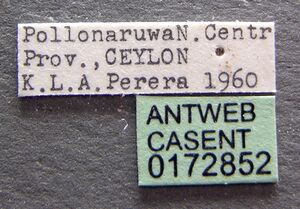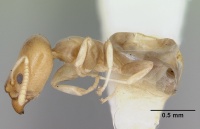Tapinoma annandalei
This species was described from three soldiers and eight workers taken from two colonies collected from Pongamia trees by Dr. N. Annandale on Barkuda Island, Chilka Lake, Orissa.
| Tapinoma annandalei | |
|---|---|

| |
| Scientific classification | |
| Kingdom: | Animalia |
| Phylum: | Arthropoda |
| Class: | Insecta |
| Order: | Hymenoptera |
| Family: | Formicidae |
| Subfamily: | Dolichoderinae |
| Genus: | Tapinoma |
| Species: | T. annandalei |
| Binomial name | |
| Tapinoma annandalei (Wheeler, W.M., 1928) | |
Identification
Distribution
Latitudinal Distribution Pattern
Latitudinal Range: 19.730781° to 19.730781°.
| North Temperate |
North Subtropical |
Tropical | South Subtropical |
South Temperate |
- Source: AntMaps
Distribution based on Regional Taxon Lists
Oriental Region: India (type locality), Sri Lanka.
Distribution based on AntMaps
Distribution based on AntWeb specimens
Check data from AntWeb
Countries Occupied
| Number of countries occupied by this species based on AntWiki Regional Taxon Lists. In general, fewer countries occupied indicates a narrower range, while more countries indicates a more widespread species. |

|
Estimated Abundance
| Relative abundance based on number of AntMaps records per species (this species within the purple bar). Fewer records (to the left) indicates a less abundant/encountered species while more records (to the right) indicates more abundant/encountered species. |

|
Biology
One nest was collected from a dead branch of Pongamia tree, with termites. Several minute Pselaphid beetles present with the ants. The females, as well as the workers, carry the grubs. Several females were present, and a large number of grubs and pupae. Another nest was collected from an irregular mass of earthy matter in the hollow of a dead stump of a branch of Pongamia glabra, much more populous than the previous one and with no termites present.
The word 'females' in these notes must refer to the soldiers. These, of course, judging from the volume of their gasters, may, perhaps be fertile and really represent or replace the queens in the colonies. The small eyes, very pale color and thin integument show that both the soldiers and workers must lead a concealed life. They probably leave the nest only at night.
Castes
Worker
Images from AntWeb
   
| |
| Worker. Specimen code casent0172853. Photographer April Nobile, uploaded by California Academy of Sciences. | Owned by MCZ, Cambridge, MA, USA. |
Queen
Images from AntWeb
   
| |
| Queen (alate/dealate). Specimen code casent0172855. Photographer April Nobile, uploaded by California Academy of Sciences. | Owned by MCZ, Cambridge, MA, USA. |
Male
Images from AntWeb
     
| |
| Male (alate). Specimen code casent0172852. Photographer April Nobile, uploaded by California Academy of Sciences. | Owned by MCZ, Cambridge, MA, USA. |
Nomenclature
The following information is derived from Barry Bolton's Online Catalogue of the Ants of the World.
- annandalei. Zatapinoma annandalei Wheeler, W.M. 1928a: 20, fig. 1 (s.w.) INDIA. Combination in Tapinoma: Shattuck, 1992c: 152.
Description
Unless otherwise noted the text for the remainder of this section is reported from (Wheeler, 1928)
Workers
Soldier (major worker) (Figs. 1a and 1b)
Length 2.8-3 mm. Head one and one half times as long as broad, as broad in front as be hind, with straight, parallel sides, very feebly convex posterior border and rounded posterior corners; in profile as high in front as behind, with straight dorsal and gular contours. Eyes small, flat or even slightly concave, elliptical, with about a dozen facets in their greatest longitudinal diameter, situated just in front of the median third of the head. Mandibles large and convex, with evenly arcuate external borders, the apical borders with nine or ten coarse, alternately large and small teeth. Clypeus more than three times as broad as long, high and truncated anteriorly, on each side with an oblique, blunt, somewhat bilobed ridge or projection, the anterior border nearly straight in the middle, bluntly projecting at each corner. Frontal carinæ somewhat further apart than the distance of either from the lateral border of the head. Frontal area rather indistinct, large and triangular; frontal groove lacking. Antennal scapes curved at the base, slightly thickened apically, their tips reaching only to the posterior two fifths of the sides of the head; funiculi distinctly enlarged toward the tip; first joint somewhat more than twice as long as broad, joints 2-10 somewhat broader than long, the second much smaller and more transverse than the third, the tenth very nearly as long as broad. Thorax short, with robust pro and mesonotum, but much narrower than the head, the pronotum broader than long, convex, with rounded humeri; the mesonotum also convex above and rising somewhat above the pronotum, nearly as broad as long, narrowed posteriorly to the distinct but shallow mesoëpinotal impression. Epino tum as long as broad, with rectangular ventral outline, narrower than the anterior portion of the mesonotum, in profile with short base and long. sloping and rather flat declivity. Petiole subrectangular, slightly broader than long.
Smooth and nearly opaque or slightly glossy; mandibles and clypeus opaque, very finely, densely and indistinctly punctate-reticulate. Hairs whitish, short, very few in number and confined to the mandibles, clypeus, tips of antennal scapes and tip of gaster. Pubescence white, short, delicate and inconspicuous, rather uniformly distributed over the whole body, somewhat denser on the appendages. Pale whitish yellow; mandibles and clypeus yellowish brown; mandibular teeth and eyes black; bases of gastric segments brownish.
Length- 2.8-3 mm
Worker (minor worker) (Fig. 1c)
Head rounded subrectangular, very slightly longer than broad, slightly narrower in front than behind, with broadly rounded posterior corners and slightly convex posterior border. Eyes feebly convex, in front of the median transverse diameter of the head. Mandibles less convex than in the soldier. with four large, unequal apical teeth and ten crowded, subequal basal dent icles. Clypeus convex and evenly rounded, not truncated or raised anter forly, with straight, entire anterior border. Frontal area indistinct; frontal carine very short and widely separated, as in the soldier. Antennal scapes not reaching to the posterior border of the head. Thorax and petiole much as in the soldier, but the pro-and mesonotum less robust, the gaster smaller, shorter and broadly elliptical. Femora somewhat less dilated.
Smooth and sub-opaque like the soldier, but the mandibles and clypeus not differently sculptured from the remainder of the body. Pilosity and pubescence even finer and more indistinct than in the soldier. Entirely pale whitish yellow, except the mandibular teeth, which are reddish. Even the eyes seem to have lost most of their pigment in the dried specimens.
Length- 1.3-1.5 mm
References
- Cantone S. 2018. Winged Ants, The queen. Dichotomous key to genera of winged female ants in the World. The Wings of Ants: morphological and systematic relationships (self-published).
- Shattuck, S. O. 1992c. Generic revision of the ant subfamily Dolichoderinae (Hymenoptera: Formicidae). Sociobiology 21: 1-181 (page 152, Combination in Tapinoma)
- Wheeler, W. M. 1928a. Zatapinoma, a new genus of ants from India. Proc. N. Engl. Zool. Club 10: 19-23 (page 20, fig. 1 soldier, worker described)
References based on Global Ant Biodiversity Informatics
- Wheeler W. M. 1928. Zatapinoma, a new genus of ants from India. Proceedings of the New England Zoological Club 10: 19-23.

